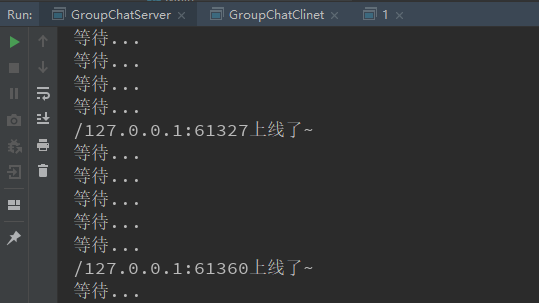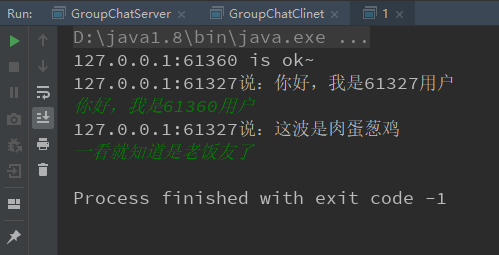接下来进行一个实战例子,用NIO实现一个多人运动版本的聊天室。
服务端代码:
public class GroupChatServer {
private Selector selector;
private ServerSocketChannel serverSocketChannel;
public static final int PORT = 6667;
public GroupChatServer() {
try {
this.selector = Selector.open();
this.serverSocketChannel = ServerSocketChannel.open();
this.serverSocketChannel.bind(new InetSocketAddress("127.0.0.1", PORT));
serverSocketChannel.configureBlocking(false);
serverSocketChannel.register(selector, SelectionKey.OP_ACCEPT);
} catch (Exception e) {
e.printStackTrace();
}
}
public void listen() {
try {
while (true) {
int count = selector.select(2000);
if (count > 0) {
Set<SelectionKey> selectionKeys = selector.selectedKeys();
Iterator<SelectionKey> it = selectionKeys.iterator();
while (it.hasNext()) {
SelectionKey key = it.next();
if (key.isAcceptable()) {
SocketChannel socketChannel = serverSocketChannel.accept();
socketChannel.configureBlocking(false);
socketChannel.register(selector, SelectionKey.OP_READ);
System.out.println(socketChannel.getRemoteAddress() + "上线了~");
}
if (key.isReadable()) {
readData(key);
}
it.remove();
}
} else {
System.out.println("等待...");
}
}
} catch (Exception e) {
e.printStackTrace();
}
}
private void readData(SelectionKey selectionKey) {
SocketChannel socketChannel = null;
try {
socketChannel = (SocketChannel) selectionKey.channel();
ByteBuffer byteBuffer = ByteBuffer.allocate(1024);
int count = socketChannel.read(byteBuffer);
if (count > 0) {
String msg = new String(byteBuffer.array());
System.out.println("from 客户端:" + msg);
notifyAllClient(msg, socketChannel);
}
} catch (Exception e) {
try {
System.out.println(socketChannel.getRemoteAddress() + "离线了...");
selectionKey.cancel();
socketChannel.close();
} catch (IOException e1) {
e1.printStackTrace();
}
}
}
private void notifyAllClient(String msg, SocketChannel noNotifyChannel) throws Exception {
System.out.println("服务器转发消息~");
for (SelectionKey selectionKey : selector.keys()) {
Channel channel = selectionKey.channel();
if (channel instanceof SocketChannel && channel != noNotifyChannel) {
SocketChannel socketChannel = (SocketChannel) channel;
ByteBuffer byteBuffer = ByteBuffer.wrap(msg.getBytes());
socketChannel.write(byteBuffer);
}
}
}
public static void main(String[] args) throws Exception {
GroupChatServer chatServer = new GroupChatServer();
chatServer.listen();
}
}
|
客户端代码:
public class GroupChatClinet {
private Selector selector;
private SocketChannel socketChannel;
private String userName;
public GroupChatClinet() {
try {
this.selector = Selector.open();
socketChannel = SocketChannel.open(new InetSocketAddress("127.0.0.1", GroupChatServer.PORT));
socketChannel.configureBlocking(false);
socketChannel.register(selector, SelectionKey.OP_READ);
userName = socketChannel.getLocalAddress().toString().substring(1);
System.out.println(userName + " is ok~");
} catch (Exception e) {
e.printStackTrace();
}
}
private void sendMsg(String msg) {
msg = userName + "说:" + msg;
try {
socketChannel.write(ByteBuffer.wrap(msg.getBytes()));
} catch (Exception e) {
e.printStackTrace();
}
}
private void readMsg() {
try {
int count = selector.select();
if (count > 0) {
Iterator<SelectionKey> iterator = selector.selectedKeys().iterator();
while (iterator.hasNext()) {
SelectionKey selectionKey = iterator.next();
if (selectionKey.isReadable()) {
SocketChannel channel = (SocketChannel) selectionKey.channel();
ByteBuffer byteBuffer = ByteBuffer.allocate(1024);
channel.read(byteBuffer);
System.out.println(new String(byteBuffer.array()));
}
iterator.remove();
}
}
} catch (Exception e) {
e.printStackTrace();
}
}
public static void main(String[] args) throws Exception {
GroupChatClinet chatClinet = new GroupChatClinet();
new Thread(() -> {
while (true) {
chatClinet.readMsg();
try {
Thread.sleep(3000);
} catch (Exception e) {
e.printStackTrace();
}
}
}).start();
Scanner scanner = new Scanner(System.in);
while (scanner.hasNextLine()) {
String msg = scanner.nextLine();
chatClinet.sendMsg(msg);
}
}
}
|
先启动服务端的main方法,再启动两个客户端的main方法:

然后使用两个客户端开始聊天了~







